Formation of Stars and Heavy Elements
Much of the basic chemistry of terrestrial life - the ubiquitous
CHNOPS crew, magnesium, sodium, iron - owes its presence to nuclear processing inside
earlier generations of stars, whose products were then available
to make the Sun and its planets. We can see some parts of starbirth,
and the lives and deaths of stars again furnish a rich backdrop for our
existence.
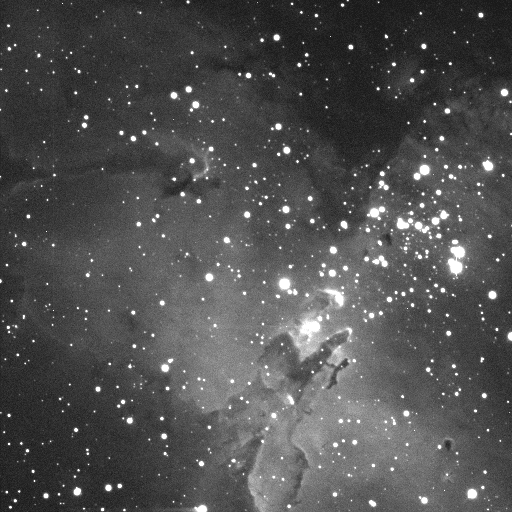 Stars form in dense clouds of gas, cold enough (there goes cooling
again) to form molecules (mostly molecular hydrogen). This gas is
cold enough that some of it can fall together gravitationally into
a volume comparable to our solar system's, at which point it is
largely in a thin disk. Some will lose its angular momentum (spin)
and fall in to make a core, which heats up as gravity compresses it.
Eventually the core becomes a star, generating energy from the
fusion of hydrogen to helium in its core. This is an instance of
Einstein's famous equation E=mc2, with 0.7% of the
mass of the initial hydrogen transformed into energy which holds the
star up in balance with gravity.(View solar
reaction network).
Stars form in dense clouds of gas, cold enough (there goes cooling
again) to form molecules (mostly molecular hydrogen). This gas is
cold enough that some of it can fall together gravitationally into
a volume comparable to our solar system's, at which point it is
largely in a thin disk. Some will lose its angular momentum (spin)
and fall in to make a core, which heats up as gravity compresses it.
Eventually the core becomes a star, generating energy from the
fusion of hydrogen to helium in its core. This is an instance of
Einstein's famous equation E=mc2, with 0.7% of the
mass of the initial hydrogen transformed into energy which holds the
star up in balance with gravity.(View solar
reaction network).
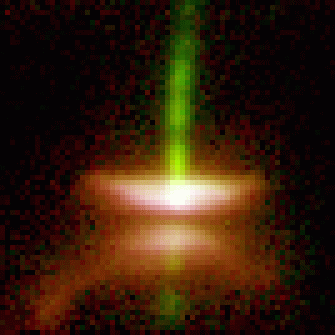 Meanwhile the gas and dust which didn't make the star itself remain
orbiting in a thin disk, as we see in many young stars. This mixture
is just what we infer was the starting point for our own
solar system. If you leave such a disk to itself, it will make planets.
Meanwhile the gas and dust which didn't make the star itself remain
orbiting in a thin disk, as we see in many young stars. This mixture
is just what we infer was the starting point for our own
solar system. If you leave such a disk to itself, it will make planets.
The lives of stars are very long on human, and sometimes geological,
timescales. The most massive stars last less than a million years, while
dim red dwarfs can keep going for trillions (they're all still babies).
We can test our understanding of stellar life cycles well on star
clusters, where the stars are about the same age but have different
masses. Our galaxy contains star clusters from 13 billion years
in age down to clusters where stars are still being born.
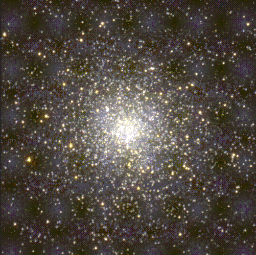
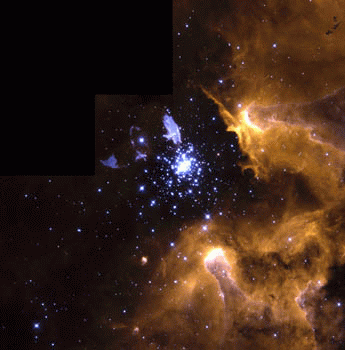
Stars don't last forever. Some kinds, at various evolutionary stages,
will expel gas back out into their surroundings. This gas may include
the products of nuclear fusion, either during the star's existence
as a sunlike main-sequence star, as a huge red giant, blown off
as a planetary nebula at the end of thet phase, or in the
cataclysmic explosion of a supernova. Different elements are important
in these events. The heaviest elements (including radioactive
isotopes) are made in the cauldron of exploding supernovae.
Carbon, nitrogen, and oxygen can be formed in red giants, and are
abundant in the planetary nebulae that result from their atmospheres
finally blowing away. The starting point in red giants - helium - leaves
its mark in the pronounced even-odd pattern of element abundances
seen on Earth and throughout the Universe. More nuclei can be built
up by adding two protons and neutrons at a time than by adding single protons.
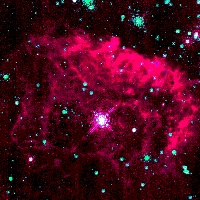


Stellar wind
Planetary nebula
Supernova explosion
Next: Formation of planets
More details:
Cosmic abundances:
graphical and
tabular versions
The beauty and mystery of planetary nebulae
keel@bildad.astr.ua.edu
Last changes: 8/2002
Much of the basic chemistry of terrestrial life - the ubiquitous
CHNOPS crew, magnesium, sodium, iron - owes its presence to nuclear processing inside
earlier generations of stars, whose products were then available
to make the Sun and its planets. We can see some parts of starbirth,
and the lives and deaths of stars again furnish a rich backdrop for our
existence.
 Stars form in dense clouds of gas, cold enough (there goes cooling
again) to form molecules (mostly molecular hydrogen). This gas is
cold enough that some of it can fall together gravitationally into
a volume comparable to our solar system's, at which point it is
largely in a thin disk. Some will lose its angular momentum (spin)
and fall in to make a core, which heats up as gravity compresses it.
Eventually the core becomes a star, generating energy from the
fusion of hydrogen to helium in its core. This is an instance of
Einstein's famous equation E=mc2, with 0.7% of the
mass of the initial hydrogen transformed into energy which holds the
star up in balance with gravity.(View solar
reaction network).
Stars form in dense clouds of gas, cold enough (there goes cooling
again) to form molecules (mostly molecular hydrogen). This gas is
cold enough that some of it can fall together gravitationally into
a volume comparable to our solar system's, at which point it is
largely in a thin disk. Some will lose its angular momentum (spin)
and fall in to make a core, which heats up as gravity compresses it.
Eventually the core becomes a star, generating energy from the
fusion of hydrogen to helium in its core. This is an instance of
Einstein's famous equation E=mc2, with 0.7% of the
mass of the initial hydrogen transformed into energy which holds the
star up in balance with gravity.(View solar
reaction network).
 Meanwhile the gas and dust which didn't make the star itself remain
orbiting in a thin disk, as we see in many young stars. This mixture
is just what we infer was the starting point for our own
solar system. If you leave such a disk to itself, it will make planets.
Meanwhile the gas and dust which didn't make the star itself remain
orbiting in a thin disk, as we see in many young stars. This mixture
is just what we infer was the starting point for our own
solar system. If you leave such a disk to itself, it will make planets.
The lives of stars are very long on human, and sometimes geological,
timescales. The most massive stars last less than a million years, while
dim red dwarfs can keep going for trillions (they're all still babies).
We can test our understanding of stellar life cycles well on star
clusters, where the stars are about the same age but have different
masses. Our galaxy contains star clusters from 13 billion years
in age down to clusters where stars are still being born.


Stars don't last forever. Some kinds, at various evolutionary stages,
will expel gas back out into their surroundings. This gas may include
the products of nuclear fusion, either during the star's existence
as a sunlike main-sequence star, as a huge red giant, blown off
as a planetary nebula at the end of thet phase, or in the
cataclysmic explosion of a supernova. Different elements are important
in these events. The heaviest elements (including radioactive
isotopes) are made in the cauldron of exploding supernovae.
Carbon, nitrogen, and oxygen can be formed in red giants, and are
abundant in the planetary nebulae that result from their atmospheres
finally blowing away. The starting point in red giants - helium - leaves
its mark in the pronounced even-odd pattern of element abundances
seen on Earth and throughout the Universe. More nuclei can be built
up by adding two protons and neutrons at a time than by adding single protons.



Stellar wind
Planetary nebula
Supernova explosion
Next: Formation of planets
Much of the basic chemistry of terrestrial life - the ubiquitous CHNOPS crew, magnesium, sodium, iron - owes its presence to nuclear processing inside earlier generations of stars, whose products were then available to make the Sun and its planets. We can see some parts of starbirth, and the lives and deaths of stars again furnish a rich backdrop for our existence.
 Stars form in dense clouds of gas, cold enough (there goes cooling
again) to form molecules (mostly molecular hydrogen). This gas is
cold enough that some of it can fall together gravitationally into
a volume comparable to our solar system's, at which point it is
largely in a thin disk. Some will lose its angular momentum (spin)
and fall in to make a core, which heats up as gravity compresses it.
Eventually the core becomes a star, generating energy from the
fusion of hydrogen to helium in its core. This is an instance of
Einstein's famous equation E=mc2, with 0.7% of the
mass of the initial hydrogen transformed into energy which holds the
star up in balance with gravity.(View solar
reaction network).
Stars form in dense clouds of gas, cold enough (there goes cooling
again) to form molecules (mostly molecular hydrogen). This gas is
cold enough that some of it can fall together gravitationally into
a volume comparable to our solar system's, at which point it is
largely in a thin disk. Some will lose its angular momentum (spin)
and fall in to make a core, which heats up as gravity compresses it.
Eventually the core becomes a star, generating energy from the
fusion of hydrogen to helium in its core. This is an instance of
Einstein's famous equation E=mc2, with 0.7% of the
mass of the initial hydrogen transformed into energy which holds the
star up in balance with gravity.(View solar
reaction network).
 Meanwhile the gas and dust which didn't make the star itself remain
orbiting in a thin disk, as we see in many young stars. This mixture
is just what we infer was the starting point for our own
solar system. If you leave such a disk to itself, it will make planets.
Meanwhile the gas and dust which didn't make the star itself remain
orbiting in a thin disk, as we see in many young stars. This mixture
is just what we infer was the starting point for our own
solar system. If you leave such a disk to itself, it will make planets.
The lives of stars are very long on human, and sometimes geological, timescales. The most massive stars last less than a million years, while dim red dwarfs can keep going for trillions (they're all still babies). We can test our understanding of stellar life cycles well on star clusters, where the stars are about the same age but have different masses. Our galaxy contains star clusters from 13 billion years in age down to clusters where stars are still being born.
 |
 |
Stars don't last forever. Some kinds, at various evolutionary stages, will expel gas back out into their surroundings. This gas may include the products of nuclear fusion, either during the star's existence as a sunlike main-sequence star, as a huge red giant, blown off as a planetary nebula at the end of thet phase, or in the cataclysmic explosion of a supernova. Different elements are important in these events. The heaviest elements (including radioactive isotopes) are made in the cauldron of exploding supernovae. Carbon, nitrogen, and oxygen can be formed in red giants, and are abundant in the planetary nebulae that result from their atmospheres finally blowing away. The starting point in red giants - helium - leaves its mark in the pronounced even-odd pattern of element abundances seen on Earth and throughout the Universe. More nuclei can be built up by adding two protons and neutrons at a time than by adding single protons.
 |
 |
 |
Stellar wind | Planetary nebula |
Supernova explosion |
Next: Formation of planets
More details:
keel@bildad.astr.ua.edu
Last changes: 8/2002